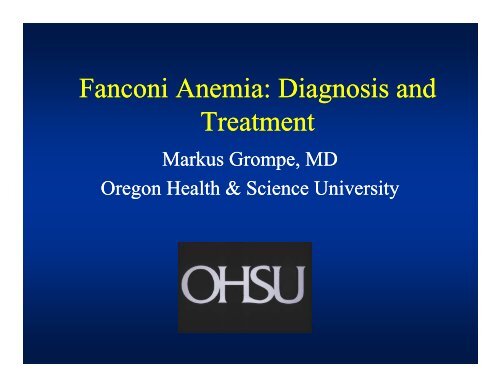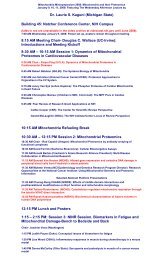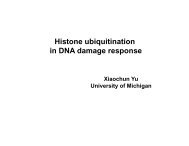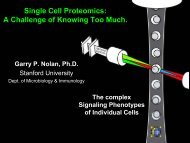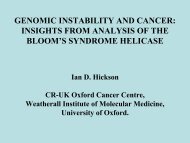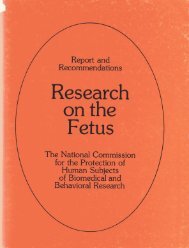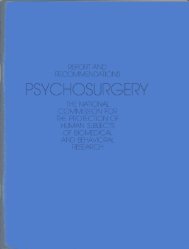Fanconi Anemia: Diagnosis and Treatment
Fanconi Anemia: Diagnosis and Treatment
Fanconi Anemia: Diagnosis and Treatment
- No tags were found...
You also want an ePaper? Increase the reach of your titles
YUMPU automatically turns print PDFs into web optimized ePapers that Google loves.
<strong>Fanconi</strong> anemia history• Named after the SwissPediatrician Guido <strong>Fanconi</strong>(1892-1979)1979)• Guido <strong>Fanconi</strong> attended theUniversity of Zürich. Beforegraduating in 1918 he trainedin Lausanne, Munich, Zürich,<strong>and</strong> Bern.• His main field of interest t was inpaediatrics, <strong>and</strong> in 1929 hebecame director of theChildren’s Hospital <strong>and</strong>professor of paediatrics at theUniversity of Zurich• His name is attached to 17conditions.
Percentage of birth defectsAbnormalityPercent in all FA patientsRadial ray defect 49Other skeletal 22Renal <strong>and</strong> urinary tract 34Male genital 20Gastrointestinal 14Heart defect 13Hearing loss 11CNS deformity 8
Image courtesyDr Blanche Alter
FA face
Image courtesyDr Blanche Alter
<strong>Anemia</strong>• Pancytopenia/progressive bone marrow failure Empty marrow on biopsy• Initial presentation can be any blood lineage• Age of onset: 2 -12 years Rarely, if ever, presents in newborn period• Red blood cell anemia macrocytic• Neutropenia• Thrombocytopenia
<strong>Fanconi</strong> <strong>Anemia</strong>: Cellular phenotype• Hypersensitivity to interstr<strong>and</strong> DNA cross-linking agents Chromosome breakage, radial formation, apoptosis Mitomycin i C, diepoxybutane, cytoxan, psoralen + UVA• Abnormal "G2/M" phase of the cell cycle spontaneously yp prolonged "G2/M" "G2/M" accumulation after crosslinker treatment• ? Oxygen sensitivity• ? Sensitivity i i to inhibitory cytokines (-IFN, TNF-)
FA karyotypeyp
Chromosome breakage read-outML# Ref L ab Clastogen ConcTot al # of Cells with th e Following Breaks perCell# % Total# ng/ml 0 1 2 3 4 5 6 7 >8 Radials Radials # of Cells8823 GM0236 1 None 0 40 8 1 1 0 0 0 0 0 0 0% 50p.13 MMC 15 4 1 2 6 5 0 0 0 3 29 58% 50DEB 150 7 1 0 5 2 1 1 0 3 30 60% 50
The Fifteen <strong>Fanconi</strong> <strong>Anemia</strong> GenesGene FA patients, Chromosome Protein product,estimated, % location kDA 60% 16q24.3 163B 2% Xp22.31 95C 10% 9q22.3 63D1/BRCA2 4% 13q12.3 380D2 4% 3p25.3 155E 10% 6p21-22 60F rare 11p15 42G 10% 9p13 68I rare 15q26 150J/BRIP1 rare 17q23.2 2 130L rare 2p16.1 52M rare 14q21.2 250N/PALB2 rare 16p12 130O/RAD51C rare 17q25.1 42P/SLX4 rare 16p13.3 200N\
The Fifteen <strong>Fanconi</strong> <strong>Anemia</strong> GenesGene FA patients, Chromosome Protein product,estimated, % location kDA 60% 16q24.3 163B 2% Xp22.31 95C 10% 9q22.3 63D1/BRCA2 4% 13q12.3 380D2 4% 3p25.3 155E 10% 6p21-22 60F rare 11p15 42G 10% 9p13 68I rare 15q26 150J/BRIP1 rare 17q23.2 2 130L rare 2p16.1 52M rare 14q21.2 250N/PALB2 rare 16p12 130O/RAD51C rare 17q25.1 42P/SLX4 rare 16p13.3 200N\
FANCD2 Monoubiquitination is a CriticalEvent in the FA pathwayBlot- anti-FANCD2(monoubiquitinated)FANCD2-LFANCD2-SwtFA-AFA-A+ +FANCAFA-CFA-C+F FANCCFA-GFA-G+F FANCGFA-F1 2 3 4 5 6 7 8 9FA-F+ +FANCFIF-anti-FANCD2(mutant)(corrected)
The Fifteen FA proteins regulate DNA crosslink repairduring S phaseE3 LigaseDNA Damagewith crosslinkin S phasePPID2I/D2 DissociatesFrom chromatinUbDNA RepairUbD2IUbI/D2 Associateswith chromatinMoldovan <strong>and</strong> D’Andrea,Ann Rev Genetics, 2009BRCA2NOJUbD2Ub I?USP1UAF1USP1/UAF1 activity isrequired for <strong>Fanconi</strong><strong>Anemia</strong> pathway
The <strong>Fanconi</strong> <strong>Anemia</strong> DNA Repair PathwayE3 LigaseDNA DamagePPID2I/D2 DissociatesFrom chromatinUbDNA RepairUbD2IUbI/D2 Associateswith chromatinMoldovan <strong>and</strong> D’Andrea,Ann Rev Genetics, 2009BRCA2NOJUbD2Ub I?USP1UAF1USP1/UAF1 activity isrequired for <strong>Fanconi</strong><strong>Anemia</strong> pathway
BRCA2 is a <strong>Fanconi</strong> <strong>Anemia</strong> Gene (D1)BreastCancerBreastCancerFA7691 insAT + - + + - -9900 insA - + + - + +Howlett, N. et al, Science 297: 606, 2002
This <strong>Fanconi</strong> <strong>Anemia</strong> (D1) patient has two mutantBRCA2 alleles1 3418aaTranscriptional1 2 3 4 5 6 7 8KKRR LKRRactivation domain Paternal AlleleNLS s1 3418aaTranscriptionalactivation domain1 2 3 4 5 6 7 8KKRR LKRRNLS sMaternal AlleleConclusion: The Breast Cancer Susceptibility Gene, BRCA2,is the <strong>Fanconi</strong> D1 Gene (> 15 D1 families identified to date)
In BRCA2 kindreds:dParadoxBRCA2 (+/-) Heterozygous Adult CarriersDevelop Breast, Ovarian, Pancreatic Cancer(Not AML)BRCA2(-/-) Children have <strong>Fanconi</strong> <strong>Anemia</strong> <strong>and</strong>Develop AML, Medulloblastoma, <strong>and</strong> WilmsTumor
<strong>Fanconi</strong> anemia <strong>and</strong> somatic• Mosaicismmosaicism Not all the cells in the patient have the same geneticmakeup. In FA, ~ 20% of all patients are mosaic in theirperipheral blood. In addition to mutant cells they also have apopulation of healthy cells
Natural history of FA• Birth defects• Pancytopenia• Leukemia• Solid tumors
B. P. Alter et al Cancer in <strong>Fanconi</strong> anemia.Blood 101 (5):2072, 2003.
Pathophysiology• DNA repair Bone marrow failure: damaged stem cells die Cancer: unrepaired mutations cause cancer Birth defects: damaged cell die• Signaling defects Bone marrow failure: cytokine hypersensitivity Cancer: Clonal evasion from cytokinehypersensitivity Birth defects: aberrant signaling during development
Non-canonical functions of FA proteins
<strong>Treatment</strong> of <strong>Fanconi</strong> <strong>Anemia</strong>Androgens Rationale: males have higher hematocrits than females• Androgens• G-CSF• Transfusions/supportive care Rdbl Red blood cells, plateletsltlt• Bone marrow transplantation• Most slides are the courtesy of John Wagner,University of Minnesota
HSCT for FA: St<strong>and</strong>ard GuidelinesHGB
100%90%Unrelated Donor BMT for FASurvival 1987-19951995100%90%80%80%Su70%70%r 60%60%viv50%40%50%40%al 30%20%18% ± 9%30%20%10%10%0%0 1 2 3Years After TransplantNMDP0%
Survival100% 100%90%Effect of Fludarabine90%Survival80%70%60%50%40%30%20%Fludarabine (n = 16)No Fludarabine (n = 68)80%70%60%50%40%30%20%10%0%P=0.0070 1 2 3Years After TransplantNovember 200110%0%
New treatments are badly needed• Gene Therapy• Cell transplantation• Small molecule intervention <strong>Treatment</strong>t PreventionCancer preventionPrevention of bone marrow failure
Is there a small molecule that can be beneficial toboth thh hematopoiesis i <strong>and</strong> cancer prevention?• Cancer prevention Enhance apoptosis of cells with damaged genomes Concern: this could lead to loss of hematopoieticstem cells• <strong>Anemia</strong> prevention Enhance survival <strong>and</strong> growth of HSC Concern: this could stimulate tumor growth• Best solution Prevent DNA damage or enhance DNA repair
Alan D’AndreaJohn PostlethwaitMarkus GrompeGrover Bagby
Heterozygosity y for Trp53accelerates tumors in Fancd2 KO*p
mammary AC10 moovarian AC13 momammary AC15 molung AC13 moosterosarcoma10 momalignant fibroushistiocytoma10 mo
First small molecule to be tested inFancd2 mutant mice
Properties of tempol• Superoxide dismutase (SOD) mimetic• Hydroxyradical y scavenger• Effective in animal models of ischemia-reperfusioninjury Myocardial infarction Renal ischemia• Effective in reducing tumor incidence in animal modelsof cancer
In vivo competitive repopulation assay:Fancc -/-3 mo.NACtreatmentBonemarrowKSL cells(2K)1200 RadBonemarrowFancd2 -/-ROSA26 Tg/+KSL cells(2K)6 monthsblood cellsGenotyping PCR
Conclusions• The SOD mimetic tempol significantly delays tumors in an FAanimal model.• This effect is not specific for FA, but also has been seen in 3other tumor-prone mouse models.• Oxidative damage may be the main source of DNA damage inFA, but also other tumor models in mice.• Tempol does not adversely affect the repopulating ability of FAmutant stem cells.• Should we have a clinical trial with a) tempol, b) another SOD-mimetic?
Other compounds that have been• Chloroquine• N-Acetylcysteinetested
From:Maclean KH, Dorsey FC, Clevel<strong>and</strong> JL, Kastan MB.J Clin Invest. 2008 Jan 2;118(1):79-88.
ATMATMchloroquinePATMPPoxidative stress
Mean tumor-free survival:Placebo: 11.5 monChloroquine: 12 monP=0.64
Models for hematopoietic defectsin <strong>Fanconi</strong> <strong>Anemia</strong>Is it really true that FA knockoutmice are not a model for the anemia?
Reduced numbers of stem cells
Reduced colony forming ability
Changes in cell cycle status of stemcells
Hematopoietic defects in Fancd2-/-mice• Reduced numbers of KLS stem cells• Reduced repopulation ability• Reduced CFU-S• Reduced d colony forming ability (cobblestoneassay)• Decreased pool of quiescent (G0) stem cells
SRT3025 (“SirT Diet”) treatment increased the frequenciesof KSL cells in both D2 mutant <strong>and</strong> wildtype miceP < 0.01KSL %P < 0.01PlaceboFancd2 -/-SRT3025Fancd2 -/-PlaceboFancd2 +/+SRT3025Fancd2 +/+
Conclusions• Fancd2 mutant mice have several hematopoieticdefects, which can be used to test drugs for theirpotential to ameliorate the defect• The FA defects affects the stem cells themselvesas well as the stroma• The Sirt1 mimetic resveratrol ameliorates someof these hematopoietic i defects• Srt3025 significantly increases the number ofstem cells in both wild-type <strong>and</strong> FA mutantmice
Cancer Cells are often defective in one DNARepair PathwayNormal cellsCancer cells+ + + + + + − + + + + +Six normal DNArepair pathwaysKennedy <strong>and</strong> D’Andrea, J.C.O. 24: 3799, 2006BBRCA1mutationPredicts PARPisensitivity ofbreast cancerThe specific pathway lostmay determine the bestcourse of chemotherapy<strong>and</strong> radiation(personalized medicine)
Cancer Cells are often defective in one DNARepair PathwayNormal cellsCancer cells+ + + + + + + + + +ERCC1mutation+Predicts cisplatinsensitivity oflung cancerSix normal DNArepair pathwaysKennedy <strong>and</strong> D’Andrea, J.C.O. 24: 3799, 2006The specific pathway lostmay determine the bestcourse of chemotherapy<strong>and</strong> radiation(personalized medicine)
Cancer Cells are often defective in one DNARepair PathwayNormal cellsCancer cells+ + + + + + + + + + +MGMTsilencingPredicts TMZsensitivity ofbrain cancerSix normal DNArepair pathwaysKennedy <strong>and</strong> D’Andrea, J.C.O. 24: 3799, 2006The specific pathway lostmay determine the bestcourse of chemotherapy<strong>and</strong> radiation(personalized medicine)
Using Synthetic Lethalityto treat tumors withUnderlying defects in the<strong>Fanconi</strong> <strong>Anemia</strong> Pathway
Since 5-20 % of solid tumors in the generalpopulation have a defect in the FA pathway,we would like to find targeted therapies forthese tumors.Used the principle of “Synthetic Lethality”
Screening Approach to Identify Gene Targets in FA Cells.FA CorrectedFA MutantDay 1Cells seeded400 Gene TargetsDay 2Each well transfectedwith siRNA oligonucleotideDNA repairsiRNA libraryDay 6 yMeasure Cell viability withATP-activated luminiscence(quantitative measure)
siRNA Targets Specifically Toxic to FAPathway Deficient i CellsGenePARP1NEIL1LIG1LIG3NBS1RAD50ATMFunctionBERBERBER/DNA replicationBERMRN complex-DSBresponseMRN complex-DSBresponseDSB signaling
siRNA Targets Specifically Toxic to FAPathway Deficient i CellsGenePARP1NEIL1LIG1LIG3NBS1RAD50ATMFunctionBERBERBER/DNA replicationBERMRN complex-DSBresponseMRN complex-DSBresponseDSB signalingSmallMoleculeInhibitorsAvailable
FA Cell Lines Are Hypersensitive to the ATMInhibitor, Ku55933Viability120 FANCE MutFANCE Corr10080604020FA-E CellsPe ercentage Contr rolFA-G Cells120FANCG MutFANCG Corr100806000 5 10 15 20 25Dose Ku55933 (uM)400 5 10 15 20Dose Ku55933(uM)Percentage Co ontrol120 FANCD2 MutFANCD2 Corr100806040FA-D2 Cells2000 5 10 15 20Dose Ku55933(uM)
FA Cell Lines Are Hypersensitive to the ATMInhibitor, Ku55933Viability120 FANCE MutFANCE Corr10080604020FA-E CellsPe ercentage Contr rolFA-G Cells120FANCG MutFANCG Corr1008060Percentage Co ontrol00 5 10 15 20 25Dose Ku55933 (uM)120 FANCD2 MutFANCD2 Corr10080604020FA-D2 Cells400 5 10 15 20Dose Ku55933(uM)Synthetic Lethal Relationshipsof DNA repair pathways arereciprocal00 5 10 15 20Dose Ku55933(uM)
Conclusions:1) Conventional cancer treatments (Radiation <strong>and</strong> Chemotherapy) killtumors by causing DNA damage.2) There are six major DNA Repair pathways, <strong>and</strong> each pathway hassuitable biomarkers <strong>and</strong> druggable targets3) There is an emerging class of DNA repair inhibitors which h maybe useful in cancer chemotherapy as sensitizers of conventionaltreatments.4) Based on the principle of Synthetic Lethality, DNA repair inhibitors,such as Parp or Atm inhibitors, may be useful as Monotherapy for somecancers with underlying DNA repair defects.5) Biomarkers of the FA pathway provide a convenient predictor ofsubsets of human tumors which are sensitive to Parp <strong>and</strong> Atm pinhibitors. relevant


